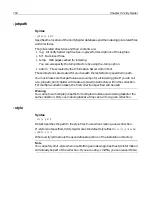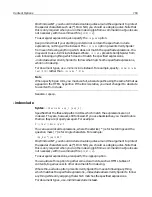
Processing Options
155
By default, a document checksum is computed based on the CRC-32 algorithm. The
checksum combined with the document size is used to determine if the document is
a duplicate.
See also
-followdup
.
-noindex
Specifies that the Verity Spider gathers document locations without indexing them.
The document locations are stored in a bulk insert file (BIF), which is then submitted
to the collection. This option is typically used in conjunction with a separate
indexing process, such as
mkvdk
or collection servicers (
collsvc
). The BIF will be
processed by the next indexing process run for the collection, whether it is the Verity
Spider,
mkvdk
or collection servicers (
collsvc
).
Do not try to start both the Verity Spider and another process at the same time. You
must allow Verity Spider enough time to generate enough work for the secondary
indexing process to act upon. If you are using
mkvdk
, you can run it in persistent
mode to ensure it will act upon work generated by Verity Spider.
Note
When you execute an indexing job for a collection and you use
-noindex
, the
persistent store for the collection is not updated.
See also
-nocache
and
-nosubmit
.
For more information on
mkvdk
, see
Chapter 9, “Managing Verity Collections with the
mkvdk Utility” on page 185
.
-nosubmit
Specifies that the Verity Spider gathers document locations without indexing them.
The document locations are stored in a bulk insert file (BIF), which is not submitted
to the collection. This option is typically used in conjunction with a separate
indexing process, such as
mkvdk
or collection servicers (
collsvc
). You can also use
Verity Spider again with the -processbif option. Note that with an indexing process
other than Verity Spider, you must specify the name and path for the BIF because the
collection has no record of it.
-persist
Syntax
:
-persist num_seconds
Enables the Verity Spider to run in persistent mode, checking for updates every
num_seconds
seconds until it is stopped.
While the Verity Spider is running in persistent mode, there is no optimization. Once
the Verity Spider is taken out of persistent mode, you will need to perform
optimization on the collection. For more information about using
mkvdk
Chapter 9,
“Managing Verity Collections with the mkvdk Utility” on page 185
.
Summary of Contents for COLDFUSION 5-ADVANCED ADMINISTRATION
Page 1: ...Macromedia Incorporated Advanced ColdFusion Administration ColdFusion 5...
Page 20: ......
Page 56: ...38 Chapter 1 Advanced Data Source Management...
Page 74: ...56 Chapter 2 Administrator Tools...
Page 76: ......
Page 86: ...68 Chapter 3 ColdFusion Security...
Page 87: ...To Learn More About Security 69...
Page 88: ...70 Chapter 3 ColdFusion Security...
Page 130: ...112 Chapter 5 Configuring Advanced Security...
Page 132: ......
Page 154: ...136 Chapter 6 Configuring Verity K2 Server...
Page 162: ...144 Chapter 7 Indexing XML Documents...
Page 202: ...184 Chapter 8 Verity Spider...
Page 236: ...218 Chapter 10 Verity Troubleshooting Utilities...
Page 238: ......
Page 348: ...330 Chapter 14 ClusterCATS Utilities...
Page 349: ...Using sniff 331...
Page 350: ...332 Chapter 14 ClusterCATS Utilities...
Page 362: ...344 Chapter 15 Optimizing ClusterCATS...
Page 372: ...354 Index...
















































